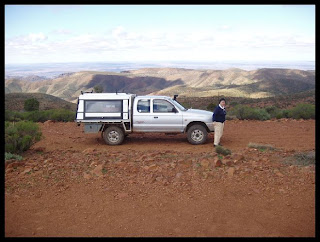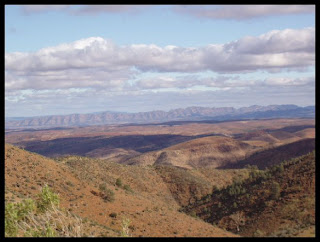This was the morning we had decided to do “Skytrek”. It was recommended to me by Frank Stoffels from Ballina Automotive and Performance.
You may well ask what is “Skytrek”? “Skytrek” is one of the most popular and exhilarating four wheel drive journeys in Australia. It is set on “Willow Springs” station, which joins the Finders Ranges National Park, and is just 21 kilometres north of Wilpena Pound.
This station is owned and managed by the Reynolds family. They have had it for more than 80 years and have so far withstood the ravages of this part of the world. They have looked after this fragile environment very well but the harshness of droughts has forced them to add tourism into their daily lives on this station.
The Reynolds not only work the station, as they have done for a long time, but also have caravan and camping sites on the front part of the station. “Skytrek” is an additional way for them to eke out a living. The owner told me that they normally run 5,000 sheep and some cattle but due to the prolonged drought, they have only about 1,500 including a few lambs. There are only a few cattle.
This trek took us through majestic river red gum lined 
To start this trek, firstly you must make a booking and arrive at the station quite early in the morning Secondly, on arrival at the station you are briefed on the trip and given a key to gain access through several gates. The trip will take no less than 6 hours but we took around 8 hours.
After collecting the key, we started our journey at a start point where you reset your trip meter so that you are aware of the interesting points along the way. Each point is well marked with a specific number. The number relates to a description on sheet that you are given on arrival.
We cruised along at a very steady pace while taking in the early sights such as the steep and rocky hill rising up beside us along with the beautiful trees such as the River Red gums. The description on the sheet told us a lot about the trees and in this case, the River Red gums.
Further along and in several locations we came across the Yacca or Australian Grasstree. 
In several locations, we stopped and looked at Aboriginal engravings which are believed to be thousands of years old. They are quite hard to see as the age has seen the rocks become hard and glossy after the engravings were put on. Apparently, this is a method of aging the works.
One of the features of this station is the abundance of water. This was one of the reasons the family originally purchased the station. The water is quite reliable even in this very dry environment. We noticed numerous windmills and tanks on our trek.
We came across a small type of tree, which is known as Bullock Bush. 
Near the Bullock Bush, we viewed slate that had endured water rippling 
In this arid area, we came across an old shepherd’s hut that has been restored by the Nissan Patrol Club. 
On our way around, we saw a lot of species of kangaroos and wallabies as well as emus. There is Bunker Reserve which is established for the preservation of the Yellow footed Rock Wallaby. This is an area that has been set aside to not only preserve this wallaby but also to protect the natural vegetation. The whole property is being managed along these lines but the lack of rainfall slows things down but it is visible especially where areas have been restored. As we started to leave the lower lands we saw more of the areas that have been locked out for restoration.
Now the fun was beginning. The Bravo was engaged into four wheel drive low range. This was the case for almost 30 kilometres of the trek of a total of just over 60 kilometres. Some of the climbs were so steep that we looked at the sky as we come over a rise not knowing where the road turned. The track was rocky/stoney and often had deep wheel tracks. This is not for the faint hearted although I did feel that way on several occasions!
There was a brilliant view as we crested most of the climbs. That is what made the trek so rewarding. One view was across to the barytes mine owned by Commercial Minerals. Baryte is often used as an oil drilling mud, manufacture of paint, brake linings, glass, paper, linoleum and the unpleasant barium meal.
We travelled on marvelling at the incredible sights. Soon we stopped for lunch in a little valley. Soon we were joined by another couple form Adelaide. It was nice to have a brief chat with them and share experiences. While having lunch, another family passed by and we caught up with them later on several occasions.
About 11 kilometres from the homestead, but still about 2 hours away, we arrived at Mount Caernarvon. It is 920 metre above sea level. The view of the Flinders Ranges and for at least 100 kilometres around is something to behold. It was so steep at the top and all sides it was like being in a light aircraft. Wow! It is so fantastic to take in this scenery without moving. The only reason we eventually did move was it was windy and cold and time was moving on.
Now we descended down some extremely steep slopes. 
Eventually, we were almost back but there was a short visit to “Skull Rock”. 
So our most interesting and exciting day had ended back at the homestead. If you come this way, it is a must see and do. If you do not own a medium to heavy four wheel drive there are tours that can be arranged. Frank certainly made a great suggestion to me.
The evening was dinner at the Wilpena Resort. Sadly, it was very slow service. I do not know what was wrong but I heard several people mention it to the staff. Prue’s meal was quite cool when served and was sent back for reheating. The meals were nice otherwise but the service was appalling. We did have a nice red wine there produced by Peter Lehmann and it was called “Clancy”.
So ended a fantastic day








No comments:
Post a Comment